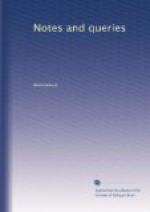“A Sympathetic Cure for the Tooth-ach.—With an iron nail raise and cut the gum from about the teeth till it bleed, and that some of the blood stick upon the nail, then drive it into a wooden beam up to the head; after this is done you never shall have the toothach in all your life.” The author naively adds “But whether the man used any spell, or said any words while he drove the nail, I know not; only I saw done all that is said above. This is used by severall certain persons.”
Amongst other “choice and experimental receipts” and “curiosities” which in this little tome are recommended for the cure of some of the “ills which flesh is heir to,” one directs the patient to
“Take two parts of the
moss growing on the skull of a dead man
(pulled as small as you can
with the fingers).”
Another enlarges on the virtue of
“A little bag containing some powder of toads calcined, so that the bag lay always upon the pit of the stomach next the skin, and presently it took away all pain as long as it hung there but if you left off the bag the pain returned. A bag continueth in force but a month after so long time you must wear a fresh one.”
This, he says, a “person of credit” told him.
HENRY CAMPKIN.
Reform Club, June 21. 1850.
Cure for Ague.—One of my parishioners, suffering from ague, was advised to catch a large spider and shut him up in a box. As he pines away, the disease is supposed to wear itself out.
B.
L—— Rectory, Somerset, July 8. 1850.
Eating Snakes a Charm for growing young.—I send you the following illustrations of this curious receipt for growing young. Perhaps some of your correspondents will furnish me with some others, and some additional light on the subject. Fuller says,—
“A gentlewoman told an ancient batchelour, who looked very young, that she thought he had eaten a snake: ‘No, mistris,’ (said he), ’it is because I never {131} meddled with any snakes which maketh me look so young.’”—Holy State, 1642, p. 36.
He hath left off
o’ late to feed on snakes;
His beard’s
turned white again.
Massinger, Old Law, Act v. Sc. 1.
“He is your
loving brother, sir, and will tell nobody
But all he meets,
that you have eat a snake,
And are grown
young, gamesome, and rampant.”
Ibid, Elder Brother, Act iv. Sc. 4.
JARLTZBERG.
* * * * *
LONG MEG OF WESTMINSTER.
Mr. Cunningham, in his Handbook of London (2nd edition, p. 540.), has the following passage, under the head of “Westminster Abbey:”




